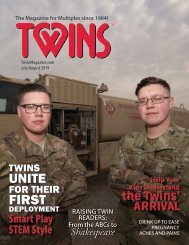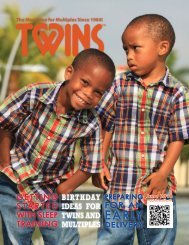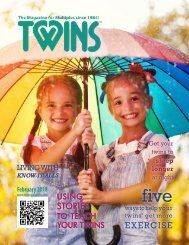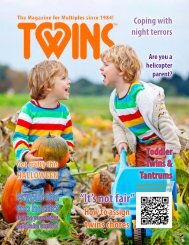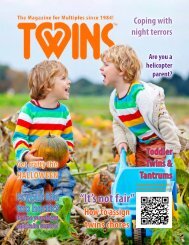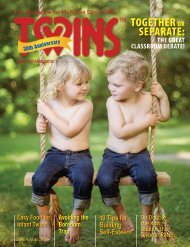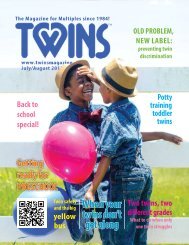Twins Magazine 2004 January February
Canadian family with four sets of twins sets Hardwired to Connect HMO forced to pay for TTTS surgery Holiday Survival Guide Oh my word! RSV season symptoms and strategies Sparkling Snowflakes The best-laid plans The hamster project Those “loving feelings” are hard to find Twins galore Two treatments help TTT babies Uh-oh! Toddler Trials and Training What causes monozygotic twinning Whining wears on single mom Help! I need somebody…
Canadian family with four sets of twins sets
Hardwired to Connect
HMO forced to pay for TTTS surgery
Holiday Survival Guide
Oh my word!
RSV season symptoms and strategies
Sparkling Snowflakes
The best-laid plans
The hamster project
Those “loving feelings” are hard to find
Twins galore
Two treatments help TTT babies
Uh-oh! Toddler Trials and Training
What causes monozygotic twinning
Whining wears on single mom
Help! I need somebody…
You also want an ePaper? Increase the reach of your titles
YUMPU automatically turns print PDFs into web optimized ePapers that Google loves.
Toddlers are known for their “No’s!” And they can gang
up on you faster than you can run in two directions at
once. Charles Fay, Ph.D., a psychologist and principal
at Love and Logic Institute, likens toddlers to tornadoes.
Twin tornadoes.
If Dr. Fay’s name sounds familiar, it’s probably because he
has spoken at the National Organization of Mothers of Twins
Clubs annual convention and at local twins clubs’ meetings
throughout the country.
“What we teach at Love and Logic, a program
that gives parents tools and techniques for
buidling healthy relationships, is that
parents should pray every day that their
children make small mistakes when they’re
young,” Dr. Fay said. “Love and Logic is
about adults modifying their behavior
and being good to themselves.
When we’re really healthy—calm,
empathetic, assertive—children
by Sharon Withers
have good role models.”
Cause and effect
The philosophy is, children learn the best lessons when they’re
allowed to make their own choices and fail when the cost of
failure is still small. Children’s failures must be coupled with
love and empathy from their parents. And this approach,
according to Fay, can begin as early as 8 to 9 months of age—
and certainly by toddlerhood. Here’s how and why.
“The goal is getting your kids to understand cause and
effect. You want them to know that when they make a poor
decision, their life is unhappy,” Fay explained.
But at 9 months old?
“You have your two little guys sitting in their high chairs.
The train is in the tunnel. Then ‘pleeh!’ One of them spits beets
all over you,” Fay said. “Love and Logic calls for sadness, not
anger. We want our children to know that we love them
unconditionally, regardless of bad decisions. So you say, ‘Oh
no, honey. That is so sad. Looks like lunch is over.’ You’re not
mad, and the consequence is logical.”
The same applies to the game of drop-and-fetch. When
your toddlers drop their spoons from the high chair to the
floor over and over again, they’re doing many things. They’re
experimenting and learning… having fun… engaging you in
their game. “It’s healthy for kids to do experiments. They need
to do these things, and it’s fine until it becomes a problem for
them or for you. You need to know where your line is… when
it is no longer cute and you need to draw the line. With toddlers,
the consequence needs to be immediate. (Delayed consequences
don’t work until children are 3 or 4 years old.)
“What we see happening more and more is kids are involved
in healthy experimenting but parents never set limits. Then toddlers
are running the house, and later you have a teenage tyrant.
Love and Logic teaches self-discipline,” Fay said.
Megan and Michelle
6 months old
Uh-oh! Toddler trials and training
Although kids can push your buttons and frustrate you—
which they love to do and see—parents can have the self-control
they need if they have some very practical parenting skills.
Three simple techniques
Parents of very young kids—kids small enough to be carried—
can think in terms of mastering three simple techniques.
" Change your location: If your kids are screaming, skip the
attempt to reason and go into another room. You might say,
“I don’t like this screaming, so I think I’ll leave the room.”
Say no more.
"Change the location of the problem object. Take away a
sharp stick or a toy truck that your twin is banging against
the wall, or on his brother’s back. Don’t get angry and lecture
or shout. “The more words we use when our kids act
up, the less effective we become. Children learn consequences
best when you don’t get angry or use too many
words,” Fay explained.
"Change the child’s location. Remove the misbehaving child to
a safe place. With twins, you need two separate locations, since
one twin often acts up as soon as his twin goes to timeout.
Timeout guidelines
Fay offers three guidelines for timeouts. First, time-in should
be really fun. “When we are with our kids and they are behaving
well we should be warm, affectionate, even silly.”
Next, timeout should remove the child from all stimulation
and attention, from you or his twin. “The more words we use,
the more attention the child gets,” Fay explained. “It is good to
have one cue word, such as ‘uh-oh,’ for timeout. Then calmly
tell your child, ‘You can come out when you are sweet.’”
Finally, the child stays in timeout until he calms down.
“The message should be, ‘I get to be with other people when I
am nice,’” Fay said.
12 JANUARY/FEBRUARY 2004 www.TwinsMagazine.com





